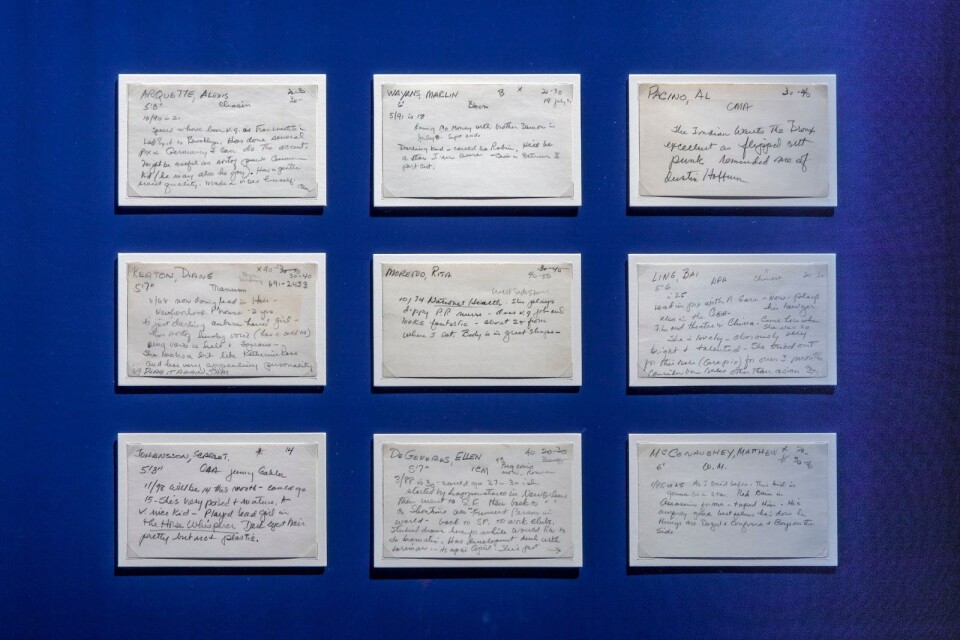With our free press under threat and federal funding for public media gone, your support matters more than ever. Help keep the LAist newsroom strong, become a monthly member or increase your support today.
This Legendary Casting Director’s Index Cards Are A Must-See For Any Film Buff

On the list of tourist destinations that locals tell you to avoid, here in L.A., the Hollywood Walk of Fame has to be pretty high up there. But what’s extra nice when steering someone away from a potential tourist trap, is when you can also suggest somewhere they go instead that’s more off-the-beaten-path and can sort of scratch the same itch. That’s where a fascinating display of hand-written index cards (stick with us here!) at The Academy Museum of Motion Pictures comes in.

Until the documentary “Casting By” came out in 2012, casting director Marion Dougherty (Butch Cassidy and the Sundance Kid, Midnight Cowboy, Lethal Weapon) was relatively unknown among the general public.
But in more recent years Dougherty — and the equally legendary casting director Lynn Stalmaster (West Side Story, The Graduate, In the Heat of the Night) — have begun to get their due credit for defining the profession of casting director and “putting together some of the most iconic casts of film history,” as casting director Lora Kennedy puts it in the new season of The Academy Museum Podcast.
The rotating display of Dougherty’s 3x5 index cards in the museum’s “Performance Gallery” (one for every actor, thousands in total) lists her overall impressions of actors she met — from the 1960s all the way to the early 2000s.
- For Ice-T: Dougherty makes note of his “kind, almost poetic” quality.
- For actor Charlize Theron: She describes her as “blond very pretty — not a bimbo at all” and says she “has a lot of poise.”
- For actor Salma Hayek: She describes her as “very beautiful — lots of chutzpah” and notes she “is from Mexico — here 6 mo. to study English.”

Lora Kennedy, who eventually stepped into Dougherty’s former role as head of casting at Warner Brothers, remembers looking through the cards when she was working as a casting assistant, years earlier, at the studio.
“When Marion would leave to go to lunch, the other assistant and I would go in and we would get those index cards out and we would read them and we would go through them and just howl at the things that she had written. Like ‘Robert Redford: cute kid, has potential,’” Kennedy told The Academy Museum Podcast. “We would literally do that every lunch when she would leave, we’re like, ‘Let's go get the cards.’”
“It's really interesting to see her insight, to see her reactions,” Academy Museum associate curator Dara Jaffe says. Jaffe co-curated the gallery on casting in the museum and is responsible for the selection of index cards on display, which rotates periodically. “For someone like Matthew McConaughey, she wrote, ‘I'm saying it now, this kid's gonna be a star.’ You know, that kind of stereotypical casting-director-speak. And of course she was 100% right.”
After poring over so many of the cards, Jaffe has found some common themes: “You see a lot of notes where she might say something like, ‘beautiful but not plastic,’ ‘not a bimbo,’ you see ‘not plastic’ a lot. She was very much looking for real people.”

And looking for “real people” was something revolutionary about how Doughtery, and her contemporary Lynn Stalmaster, went about their work after the fall of the studio system in Hollywood.
“There was now more of a priority of looking for the interior truth of a character and matching that to the actor who could best meet that,” Jaffe says. “Rather than looking at more surface-level attributes.”
Want to see for yourself?
Visit The Academy Museum of Motion Pictures and head upstairs to the “Performance Gallery” which is right next to “The Art of Moviemaking: The Godfather” exhibition (open through January 2025).
Listen
That sounds great! How do I find the podcast?
It's now available from LAist Studios. Check it out wherever you get your get podcasts! Or listen to this episode on the player above.









